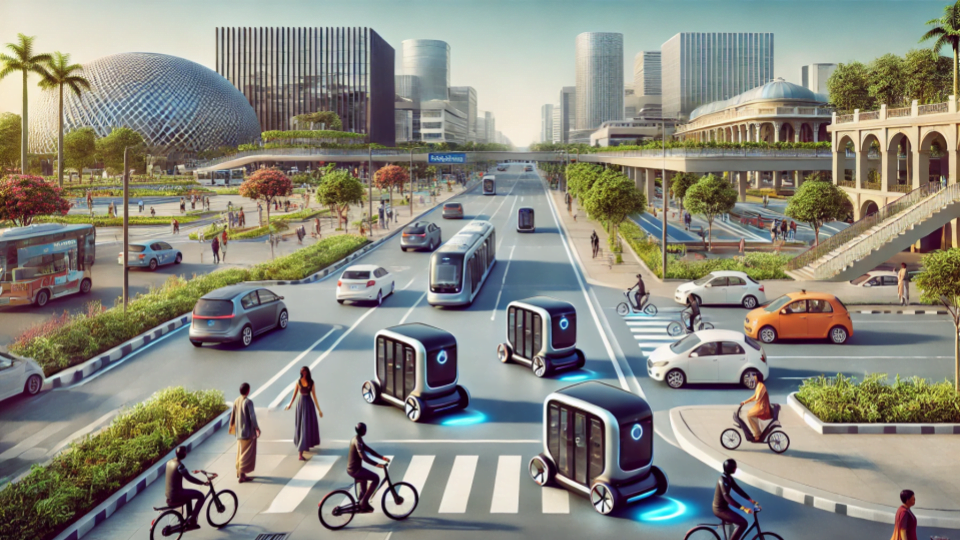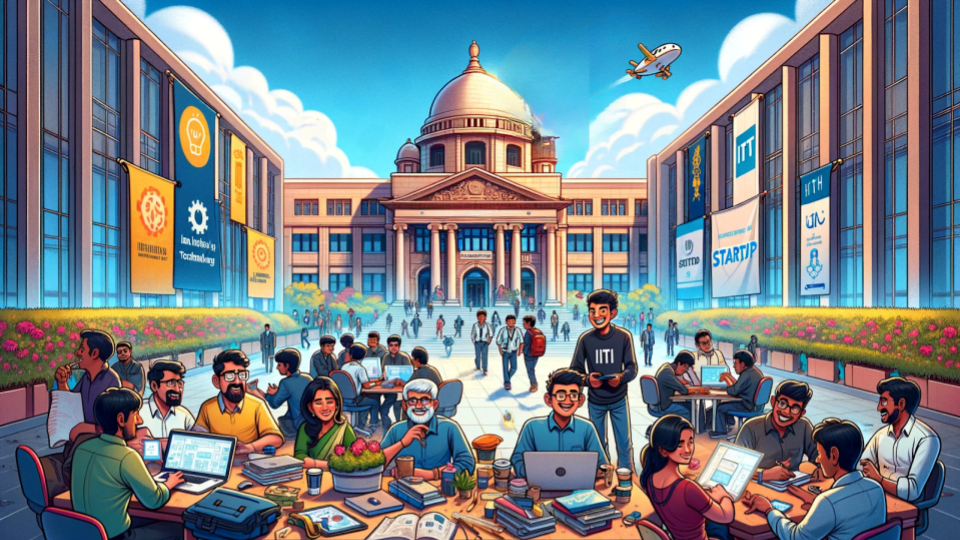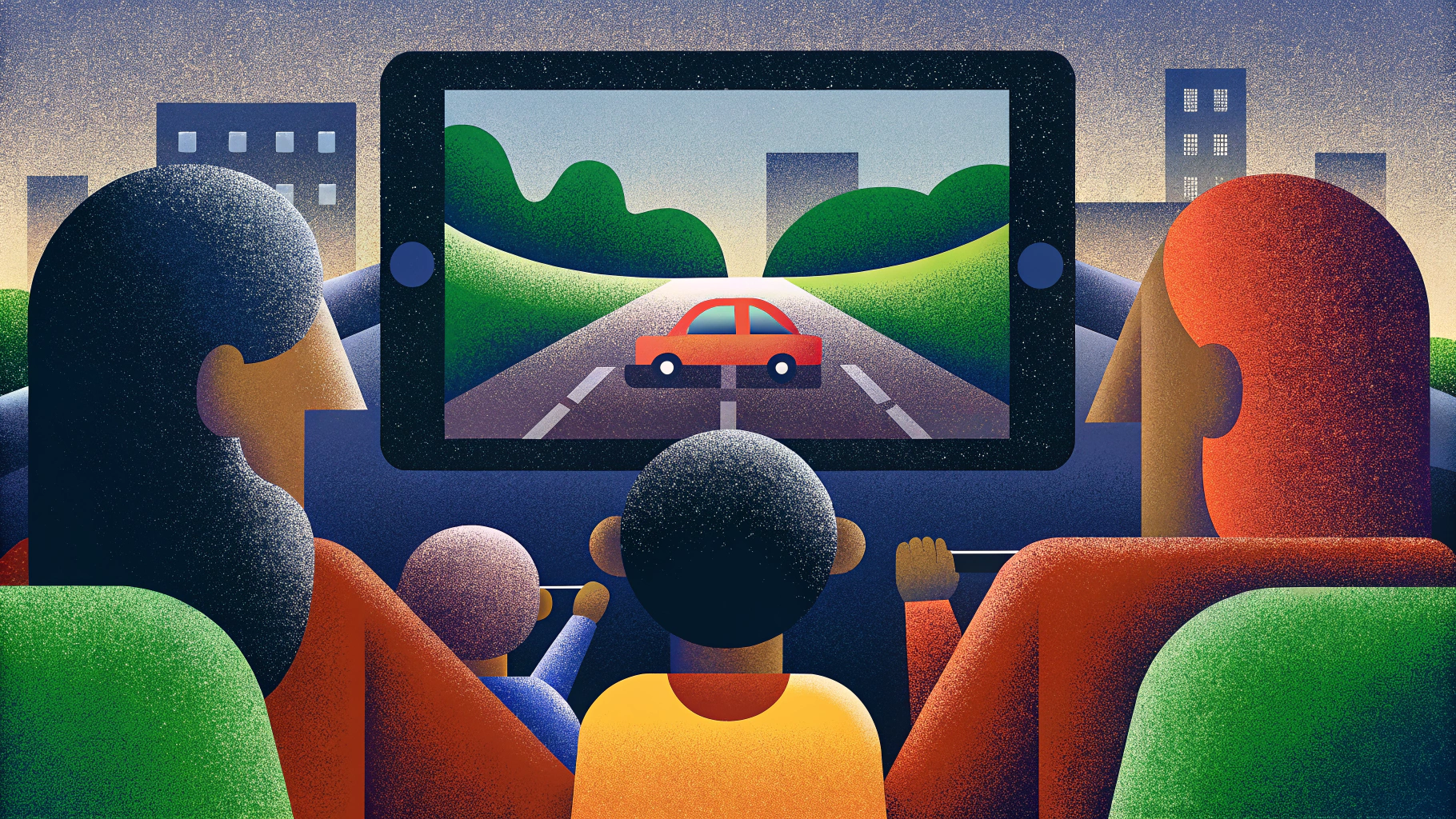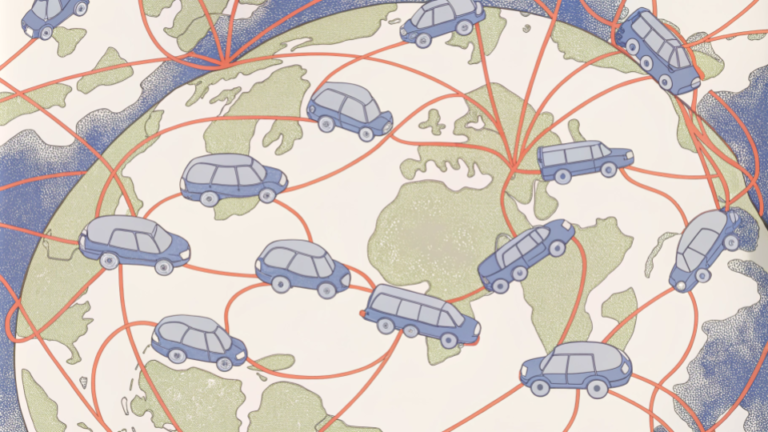Swaayat Robots : A Nitro Boost For a Driverless Future
Could you picture a world where your car dodges potholes and cows on Indian streets without a driver? That’s the world Swaayat Robots is steering us towards. They are a Bhopal-based company specializing in autonomous vehicle technology. Founded in 2015 by IIT Delhi alumnus Sanjeev Sharma, Swaayat Robots is at the forefront of developing self-driving solutions specifically designed for India’s unpredictable traffic conditions.

Lessons From Swaayat Robotics
Leverage Local Challenges as Global Opportunities
The Lesson & Why it Matters: Every local challenge presents a unique opportunity to innovate solutions that can have global applications.
Implementation: Identify specific local issues and develop solutions that can be adapted globally.
How Swaayat Robots Implements It: Swaayat began by addressing India’s complex driving environment, creating technology robust enough to be applied worldwide.
Focus on Cost-Effective Technologies
The Lesson & Why it Matters: Making technology accessible and affordable can drive widespread adoption and market penetration.
Implementation: Develop and utilize technologies that reduce costs without compromising on quality.
How Swaayat Robots Implements It: They use camera-based systems instead of expensive sensors like LiDAR, making autonomous driving technology more affordable.
Continuous R&D Investment
The Lesson & Why it Matters: Sustained research and development are vital for staying ahead in technology-intensive industries.
Implementation: Allocate consistent resources to R&D and stay updated with the latest technological advancements.
How Swaayat Robots Implements It: They continuously invest in R&D, particularly in areas like AI and machine learning, to advance their autonomous driving technologies.
Adaptability Is Key in Technology
The Lesson & Why It Matters: The tech landscape evolves rapidly; staying adaptable ensures relevance and sustainability.
Implementation: Build flexibility into the development process to accommodate new findings and technologies.
How Swaayat Robots Implements It: They continuously refine their systems, such as transitioning from relying on traditional sensors to using advanced camera-based perception.
Embrace Public Demonstrations to Gain Trust
The Lesson & Why It Matters: Demonstrations and public testing can build public trust and provide real-world data to improve products.
Implementation: Regularly showcase new technologies through public demos and pilot programs.
How Swaayat Robots Implements It: Swaayat has conducted several high-visibility demonstrations of their autonomous vehicles on Indian roads to showcase their technology’s capabilities and reliability.
Starting with a Bang: How Swaayat is Revolutionizing the Road
From chaotic city intersections to unpredictable rural roads, their technology promises to navigate it all autonomously. The startup’s approach is tailored to overcome the unique challenges of Indian roads, including unstructured environments and diverse traffic scenarios.
Swaayat’s innovation uses a camera-based perception system. This system allows vehicles to ‘see’ and respond to their environment, making the make and model of the car less critical. It’s a game-changer because it reduces the dependency on high-cost equipment, bringing down the overall cost of the technology.
By pushing the boundaries of what’s possible on the road, Swaayat Robots is engineering the future of transportation. As they continue to innovate and expand, their journey is one to watch for anyone interested in the intersection of technology and everyday life.
Sanjeev Sharma: The Brain Behind the Wheel
From a modest start-up to a major player in autonomous technology, Sanjeev Sharma’s journey with Swaayat Robots is nothing short of inspiring. Here’s a founder who didn’t just dream about autonomous vehicles; he built them from scratch on Indian soil.
Who is Sanjeev Sharma?
Sanjeev Sharma, an alumnus of the prestigious IIT Delhi, is the brainchild behind Swaayat Robots. His academic background in engineering laid the groundwork for his ventures into the complex world of autonomous driving.
The Spark of Innovation
The story of Swaayat began in 2015 when Sanjeev Sharma decided to tackle one of the most daunting challenges in technology—creating a robust autonomous driving system for India. Starting with a modest capital of less than $60,000, Sharma embarked on a journey that many thought was reserved for tech giants with deep pockets.
Sharma’s initial focus was on overcoming the reliance on expensive hardware like Lidar and Radar, which are standard in most autonomous vehicles but are prohibitively costly. By 2016, he had pivoted to developing technology that utilized cameras and artificial intelligence to perceive the road, drastically cutting down costs and making the technology more accessible.
A Self-Made Path
Operating out of Bhopal, Sharma and his team at Swaayat faced numerous challenges, from funding to the technological hurdles of adapting autonomous technology to the unpredictable Indian roads. Despite these obstacles, Sharma’s commitment to innovation never waned. He leveraged his research and mathematical skills to single-handedly craft the initial algorithms that would become the backbone of Swaayat’s technology.
Today, Sanjeev Sharma is guiding the company towards new frontiers in autonomous driving. Under his leadership, Swaayat has not only developed cutting-edge technology but also cultivated a culture of innovation and resilience that stands as a testament to the potential of Indian entrepreneurship in the global tech landscape.
Autonomous Vehicle Industry : Navigating The Road Ahead
The autonomous vehicle (AV) industry is accelerating faster than a sports car at a green light. With global market projections soaring, the future roads look set to be dominated by driverless technology.
Market Boom
Experts project it to expand from USD 41.10 billion in 2024 to a staggering USD 114.54 billion by 2029, with a robust growth rate of 22.75%. The potential is even more pronounced when looking towards 2030, with forecasts suggesting a leap to approximately USD 13,632.4 billion, powered by a compound annual growth rate (CAGR) of 32.3%. This rapid expansion is underpinned by continuous advancements in AI, sensors, and connectivity technologies that enhance vehicle autonomy. (Mordor Intelligence)
Regional Front-Runners
North America and Europe are at the forefront of this revolution. The U.S. is a significant hub due to its robust technological landscape and proactive regulatory framework. Europe is not far behind, with countries like Germany pioneering regulatory support for Level 4 autonomous vehicles. (Fortune Business Insights)
The Asia-Pacific region is catching up rapidly, expected to grow at the fastest CAGR of 25.0% from 2023 to 2030, driven by the dense urban populations of China, Japan, and South Korea, which are ideal test beds for this technology. (Grand View Research)
Innovations and Collaborations
The path to autonomy is paved with innovative partnerships and groundbreaking technological advancements. Companies are heavily investing in and collaborating on technologies that enhance safety and reduce traffic congestion. Notable collaborations include Volkswagen’s partnership with Mobileye and Daimler Truck’s joint venture with Intel’s Mobileye, focusing on Level 4 autonomous technology (Allied Market Research).
Despite the bright prospects, the road isn’t without bumps. High development costs and safety concerns remain significant hurdles. However, governments globally are easing this journey with substantial investments and by setting up regulatory frameworks that encourage AV deployment and ensure safety.
Mission Possible: Steering Towards a Driverless Tomorrow
With a clear vision and a robust mission, Swaayat Robots is actively shaping the future of autonomous driving. Their approach to solving complex navigation challenges with innovative technologies sets them apart in a competitive industry.
Mission and Vision
Swaayat Robots is laser-focused on achieving Level-5 autonomy in autonomous driving technologies. Their mission is to develop vehicles that can operate completely independently, without human intervention. By conducting high-speed autonomous driving demonstrations on Indian roads, they aim to showcase their advanced capabilities and set the stage for future innovations.
Solving Real-World Problems
The primary challenges that Swaayat Robots addresses revolve around the three main pipelines of autonomous driving: perception, localization and mapping, and planning. They have pioneered methods to achieve autonomous navigation without the dependency on high-definition maps, which is a significant breakthrough in the field. This innovation not only simplifies the technology but also reduces the costs associated with data-heavy, high-resolution mapping.
Innovative Business Model
Swaayat’s business model is built on a foundation of technological innovation and scalability. They utilize a combination of mounted cameras and AI technologies, avoiding the need for external data feeds. This approach allows them to maintain control over their technology and reduce reliance on costly external hardware like Lidars. With plans to expand their camera setup and enhance data processing capabilities, Swaayat is gearing up to secure a significant market share in the booming autonomous driving industry, projecting to capture 25% of the market by 2030 (Analytics India Magazine).
As they continue to push the boundaries of what’s possible on the roads, Swaayat Robots is undoubtedly a company to watch as they drive towards a fully autonomous future.
Swaayat Robots: A Full Spectrum of Autonomous Solutions
Swaayat Robots’ approach to technology is holistic, addressing not only the mechanical aspects of autonomous driving but also the computational and algorithmic challenges. Their ability to operate without high-fidelity maps and to innovate within the constraints of current sensor technology sets them apart in the field of autonomous driving technology.
Autonomous Driving Technology
At the core of Swaayat’s offerings is their innovative autonomous driving technology. This includes advanced motion planning and decision-making algorithms that allow vehicles to navigate through chaotic traffic without relying on expensive LiDAR systems. Instead, they utilize off-the-shelf cameras enhanced by their proprietary software to perceive and understand the environment.
Unique Features and Demonstrations
Swaayat Robots has developed several key technologies that set them apart:
- Their vehicles can execute high-speed maneuvers such as U-Turns and lane changes effectively, which have been showcased in various demonstrations. These capabilities are underpinned by their reinforcement learning-based motion planning that allows the vehicle to make real-time decisions.
- They have achieved notable success in tight environment navigation, including autonomous parking and navigating complex S-Curves, using their cutting-edge algorithms.
Research and Development Focus
Swaayat is deeply invested in R&D, focusing on reducing reliance on high-definition maps and expensive hardware. Their innovative approach includes developing algorithms that allow autonomous vehicles to operate in unknown and unseen environments, a capability that is rare globally.
Swaayat Robots continues to push the boundaries of what’s possible in the realm of autonomous driving, making significant strides toward a safer and more efficient future.
Under the Hood: The Tech Powering Swaayat’s Autonomous Drive
Cutting-Edge Motion Planning
At the core of Swaayat’s innovation is their advanced motion planning algorithm, renowned for being one of the fastest in the world. This algorithm is capable of planning trajectories in just 500 microseconds, making it possible for their vehicles to operate at speeds up to 80 km/h on challenging Indian highways. This high-speed capability is pivotal for practical applications in varied traffic conditions (Circuit Digest).
Multi-Agent Intent Analysis and Negotiation
A standout feature of their technology is the multi-agent intent analysis and negotiation framework. This system allows Swaayat vehicles to predict and interpret the actions of other road users, adjusting their path accordingly. The framework is designed to handle complex traffic scenarios, particularly in tight urban environments and high-speed highway conditions. This technology is critical for ensuring safety and efficiency in unpredictable traffic.
Reinforcement Learning and AI Integration
Swaayat leverages cutting-edge AI technologies, including reinforcement learning and apprenticeship learning, to refine their navigation policies. These AI systems are trained to handle real-world driving scenarios, further enhancing the vehicles’ ability to navigate through traffic with minimal human input. The integration of these AI methodologies underscores Swaayat’s commitment to developing autonomous vehicles capable of independent decision-making in real-time.
Optimized Hardware and Computational Efficiency
The technological infrastructure of Swaayat Robots is built to be both powerful and efficient. They utilize Nvidia GTX series GPUs to process vast amounts of data necessary for real-time autonomous driving. This setup allows them to bypass the need for cloud computing, maintaining data confidentiality and reducing latency, which is crucial for autonomous vehicle responsiveness.
Challenges Turned Into Innovations
The journey hasn’t been without its challenges. Early on, the high cost of LiDAR pushed the company to innovate with more cost-effective camera-based systems. This necessity led to significant advancements in computer vision and perception algorithms, enabling their vehicles to accurately perceive and react to their environment without relying on expensive sensor technology.
Road to Recognition: How Swaayat is Shifting Gears in the Market
Swaayat Robots and its founder, Sanjeev Sharma, have been honored multiple times for their innovative contributions to autonomous driving technology. Notably, Sharma received the “Leading 40 Under 40 Data Scientists in India” award in 2019, acknowledging his pioneering research that enabled autonomous driving on some of the world’s most challenging roads. His efforts were further recognized when he was awarded at the Global Smart Cities Congress, receiving the “51 Most Impactful Smart Cities Leaders” globally.
Influential Presentations and Talks
Sharma’s expertise and Swaayat Robots’ groundbreaking work have also led to several high-profile speaking engagements. He has presented at venues such as the International Telecommunication Union, a specialized agency of the United Nations, and has participated in panels like the India Ideas show on DD News. These platforms have not only spread the word about Swaayat’s achievements but also highlighted their role in revolutionizing transportation with AI and machine learning (Swaayatt Robots).
Impact on Autonomous Driving Industry
Swaayat’s innovative approach, particularly their use of reinforcement learning and camera-based systems to eliminate the need for expensive sensors like LiDAR, positions them as a key player in the autonomous driving sector. Their technology, capable of navigating the complex traffic of Indian roads, suggests a promising potential for global applications, offering a cost-effective, scalable solution for autonomous vehicles worldwide (Circuit Digest).
Joining Forces: Swaayat’s Strategic Alliances in the Fast Lane
One of the key partnerships that stand out for Swaayat Robots is with the Ministry of Electronics and Information Technology. This collaboration underscores the government’s support in fostering innovative technologies that are pivotal for India’s advancement in smart transportation solutions.
Additionally, Swaayat has been actively involved with accelerators like NSRCEL at IIM Bangalore and Axilor Ventures, which have played significant roles in both funding and strategic guidance, helping to scale their R&D initiatives significantly (PitchBook).
Academic and Research Collaborations
In the realm of academia, Swaayat has engaged in collaborative efforts to enhance their technological capabilities. These partnerships focus on developing cutting-edge algorithms and tackling complex challenges in autonomous driving, enhancing their system’s ability to function without high-fidelity maps—a notable advancement in the industry.
More Than Academia
Swaayat’s approach to partnerships is not confined to funding and academia alone. They are actively seeking collaborations that can offer technological synergies and innovation sharing. This strategy is pivotal as it allows Swaayat to integrate diverse technological insights into their projects, ensuring robust development in autonomous driving technologies.
Fueling Growth: The Financial Engine Behind Swaayat Robots
Swaayat Robots has made significant strides in securing financial backing to fuel its innovative pursuits in autonomous driving technology. Since its inception in 2015, the company has raised a total of $7 million across various funding rounds. The latest injection of capital came in the form of a $4 million angel investment in June 2024 from US based investors, reflecting growing confidence from investors in Swaayat’s groundbreaking approach to autonomous vehicles. (PitchBook)
Strategic Financial Partners
The company’s financial journey is supported by key partnerships with several high-profile investors. These include the Ministry of Electronics and Information Technology, NSRCEL-IIMB, Axilor Ventures, and Startup Réseau. Each has contributed not just capital but also strategic guidance crucial for Swaayat’s growth and expansion in the competitive field of autonomous driving. (Ministry of Electronics and Information Technology)
Looking Ahead
With solid financial backing and a clear strategic direction, Swaayat Robots is well-positioned to continue its path of innovation and market expansion. The continued investment into their technologies not only validates their existing achievements but also secures their place at the forefront of the autonomous driving industry. As they move forward, the focus will remain on enhancing their technological capabilities and expanding their market presence globally.
The Home Stretch: What Lies Ahead for Swaayat Robots
Swaayat Robots is an autonomous vehicle company with cutting-edge technology that’s developing technology to navigate the unpredictable of Indian roads with ease. Their approach replaces expensive sensors like LiDAR with cost-effective, camera-based systems integrated with advanced AI algorithms. This innovation not only reduces costs but also extends the technology’s reach to broader markets.
From high-speed autonomous navigation on highways to complex urban scenarios, Swaayat’s technology is designed to perform where other systems might falter. With a focus on Level-5 autonomy, they use reinforcement learning and a unique multi-agent intent analysis framework to predict and adapt to dynamic traffic conditions, setting them apart from their global counterparts.
Inspired by the journey of Swaayat Robots? There’s a road of innovation waiting for those ready to drive change. Join the conversation or start your own project. Don’t just watch the future unfold—be a part of shaping it. And for more inspiring stories and detailed explorations of cutting-edge technology, make sure to check out other articles on Venture Kites.
Questions To Ponder
Creative Head – Mrs. Shemi K Kandoth
Content By Dork Company
Art By Dork Company
100 Startups by IIT Madras in 2024: A Landmark Entrepreneurial
IIT Madras, a leader in India’s education and research, embarks on an ambitious journey. In…
Inside Indie Hackers: How a Transparent Community of Founders is
Indie Hackers, established in 2016 by Courtland Allen, is a thriving online community and resource…
Cursor: How 4 MIT Graduates Built the Fastest-Growing AI Startup
Cursor, an AI-powered integrated development environment (IDE), emerged in 2022 as one of the fastest-growing…
Vercel: This Startup Is Quietly Powering the Internet — And
Founded in 2015 by Guillermo Rauch and Naoyuki Kanezawa, Vercel—originally known as Zeit—set out to…
Tella: How This Tiny Team Is Revolutionizing Screen Recording
Tella is a modern screen recording platform built for today’s content creators and video professionals….
CarDekho: How Two IIT Brothers Changed The Way India Bought
CarDekho, a prominent name in the Indian automotive industry, has revolutionized the way people buy,…
Kovai.co: The Startup That Gave ₹14 crore To Its 140
The idea for Kovai.co started when Saravana Kumar, the CEO, was working as a software…




















Leave a Reply
You must be logged in to post a comment.